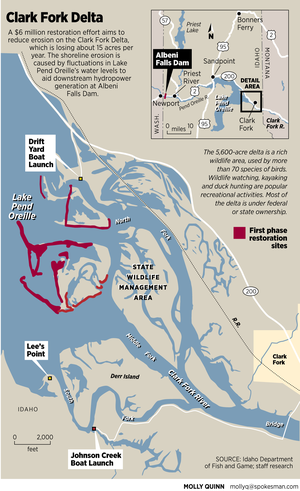Clark Fork delta restoration continues with planting
HABITAT -- Starting today, rock, willows and equipment will be barged to the the Clark Fork Delta where the mouth of the river meets Lake Pend Oreille to continue a multiyear, multimillion dollar project to keep vital wildlife habitat from eroding away.
Barges and equipment likely will still be in the area when the Idaho waterfowl hunting season opens Oct.1, probably until Oct. 5, said Kathy Cousins, Idaho Fish and Game Department biologist heading the project.
The project protecting delta islands downstream from Clark Fork, Idaho, appears to be working for fish, wildlife and people, including paddlers, as I pointed out in a recent story.
Following is a summary and update of the project written this week by Cousins.
The Clark Fork River delta enhancement project is designed to protect and improve riparian and wetland habitats in the delta, and enhance important fish and wildlife habitat. In the three years that the project has been active, a lot of improvements and stabilization have been accomplished.
Shoreline erosion became ongoing issue in the delta as a result of the construction and operation of the Albeni Falls dam and two Avista hydroelectric projects on the Clark Fork River. The Clark Fork River Delta began receding every year, resulting in an annual erosion loss of 10-22 acres of fish and wildlife habitat each year. Losses included soil, native riparian and wetland vegetation, and prime habitat for birds, mammals and fish. Eroded wetlands became mud flats.
In the winter and spring of 2015, construction and planting efforts were completed for a portion of the proposed restoration project. Over 20,000 linear feet of island shoreline rock protection was completed by placement of over 50,000 tons of rock, the planting of 51,000 willows, and the embedding of 300 pieces of large wood. By the end of June 2015, 26,387 woody plants and 74,338 emergent plants were planted by volunteers, high school students and the Idaho Youth Corp.
In June of 2016, a storm with strong winds occurred on Lake Pend Oreille, mostly along the westerly shorelines of the Clark Fork River Delta Restoration Project. The winds from the southwest had a sustained wind speed of 33 mph with gusts of 40 mph.
The partner organizations in the project agreed that the completed work held together well and performed as designed. Some wind scouring occurred where the project fronts Lake Pend Oreille. The erosion likely would have been significantly worse if restoration work had not already been completed. In these areas, the restoration engineers will be strategically placing large rock (over two feet in width), and replanting willows in the rock. Rather than using huge rocks that are not boat or wildlife friendly, the restoration project’s engineering design and approach is to build the protection so it appears more natural with vegetation growing in the rock.

